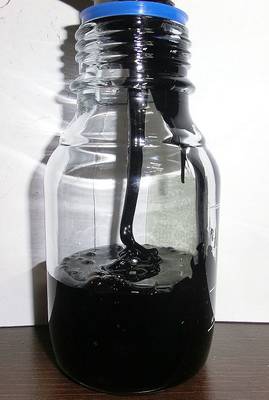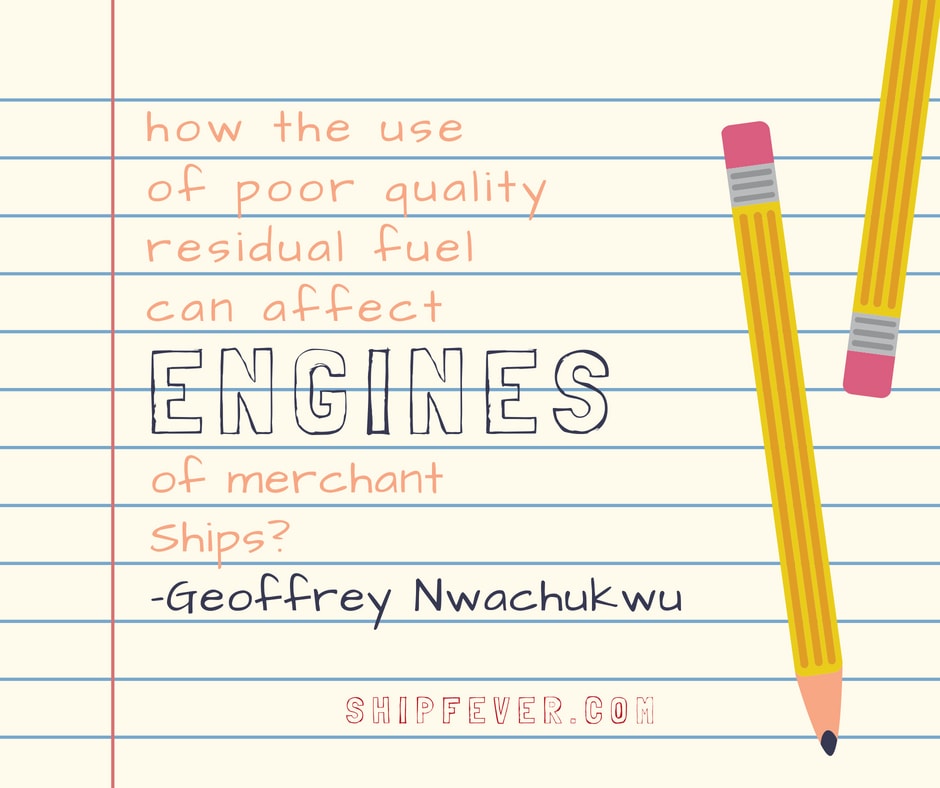Last Updated on July 27, 2020 by Amit Abhishek
Proper ignition and combustion of fuel is the key to efficient marine engine. With use of residual fuel for ignition other less important factors become critical; such as the delay period between the fuel injection and ignition.
With most of the commercial ships running on residual fuel it’s obvious to ask; How the use of poor quality residual fuel effects engine performance ( power ), turbocharger, exhaust valves, and fuel injector.
Residual fuel is not some fuel like diesel which doesn’t require much work for proper ignition and storage. But instead is the poorest form of oil possible that can be burned in any type of I.C engine.
Poor quality residual fuel can result in a number of problems including;
- Storage
- Corrosion
- Poor Combustion
- Abrasive Wear
- Chocked Injectors
- Leaky Exhaust Valves
- Frequent Cleaning of Filters
- Poor Atomization
- Engine knocking
- Steeped Ignition Pressure
- Excessive Thermal Load
- Piston and Liner wear.
What is Residual Fuel?
Slow speed marine diesel engines installed in commercial ships often run on residual fuel. Also known as bunker fuel or heavy fuel oil; these are the high density highly viscous oil produced in crude oil refineries. They are the left overs of the refining process consisting long residue, short residue, cracked oil and gasoline ( petrol ) residue.
Residual fuel oil is a low-grade fuel mixture of paraffinic and aromatic compounds. Sometimes they are blended with high-quality fuels like petrol ( gasoline ) and kerosene to obtain desired properties.
They do not have any fixed melting point and often depend on their source; but they all do have pour point as low as 30-degree centigrade. The primary use of these fuels is to power industrial boiler, power plant, and two-stroke marine diesel engines.

Characteristic Properties of Residual Fuel
The quality of marine fuel is determined by a number of following parameters; which includes viscosity, specific gravity, Carbon residue, Ash, Vanadium, Sulphur, cetane number, flash point and calorific value.
1 ) Viscosity
It is the measurement of the fuel resistance to flow at 50 degree centigrade. Normally it decreases with increase in temperature. Although it provide rough indication of carbon and asphalt content; it does not indicate the quality of oil. It also provide critical information related to atomization, handling and treatment of the fuel oil. On ship marine fuel ( H.F.O ) is heated to maintain correct injection viscosity.
2 ) Specific Gravity
It is the ratio of weight of a substance at given volume to that of equal volume of water at 15 degree centigrade. Specific gravity of a liquid or fuel is generally represented in gram per cubic centimeter or kilogram per cubic meter. Generally they are used to calculate fuel quantity on ships in each tank of given dimension.
3 ) Carbon Residue
It is the measurement of the aromatic high molecular compounds present in the fuel. High amount of its content will lead to carbon deposits and coke formation. Sometimes it is closely related to the asphaltene content in the fuel; and together leads to much of the abrasive wear in exhaust valves, combustion chamber and fuel injector.
4 ) Ash
Ash content is the measure of inorganic inorganic non-combustible impurities present in the fuel such as nickel, sand, silicon, sodium and vanadium. These inorganic compounds together leads to a large variety of problem such as localized overheating, corrosion in exhaust valves, clogged injectors with abrasive wear of piston, seat valve and injector.
5 ) Vanadium
It is a metallic substance which chemically reacts with the sodium present in the oil; during combustion process to produce highly abrasive low melting point compound leading to hot corrosion.
6 ) Sulphur
Although presence of sulphur does not directly affects the combustion process in short term; but have long lasting effects in form of cold corrosion. High sulphur content in the fuel leads to wear of piston rings, liner and piston crown. The sulphur oxides combines with the water vapour during combustion to produce sulphuric acid.
Above all high sulphur content in oil leads to air pollution in the form of SOx released in atmosphere. Marpol annex 6 restricts the use of high sulphur fuel in special areas. To counter acidity of sulphuric acid during combustion, lub oil with adequate Total Base Number are used.
7 ) Cetane Number
Ignition quality of a fuel is measured by cetane number for diesel engine. Lower the cetane number of an fuel higher is the ignition delay and longer will the time between fuel injection and rapid pressure rise. Poor injection quality leads to startup troubles and poor performance at low load condition. The cetane number of a fuel depends upon its hydrocarbon nature and extent of refining process.
8 ) Flash Point
It is the minimum temperature at which the fuel vapour can be ignited by flame of fire. A fuel with low flash point and high pour point is really dangerous to use and handle. So extreme care must be taken to avoid such condition with H.F.O by keeping the tank temperature 10 degree below its flash point.
9 ) Pour Point
It is the minimum temperature at which the fuel oil remains fluid. It is quite necessary on board ship to know the minimum temperature at which the fuel looses its fluid characteristics to ensure proper handling and pumping practices. Ideally pour point of any fluid should be around 25 degree Celsius and does not exceed 40 degree Celsius.
10 ) Calorific Value
The calorific value of a fuel oil is the measure of heat energy it can produce during a complete combustion; it is generally expressed in Kilojoule per kilogram. Theoretically calorific value of a fuel is calculated on the formula:
Calorific Value = Heat Generated / Mass of Fuel Used
How The Use Of Poor Residual Fuel Affects Engine?
There can be a number of problem arose in engine due to poor quality fuel. They can be anything from wear, corrosion, chocking, poor combustion to bacterial growth. The problem acquired with poor quality residual fuel in present day main engine are as follows:
1.Engine:
- Poor quality fuel can adversely effect the efficiency of an engine and higher temperature leading to hot corrosion.
- Using poor residual fuel can leads to deposits in combustion chamber.
- This leads to bacterial growth harming engine parts.
- Cause uneven sudden rise in combustion pressure.
- Leads to poor combustion and after burning.
- High risk of engine knocking.
- High and low temperature corrosion due to high vanadium and sulphur content in the fuel.
- Using poor quality residual fuel increase the air pollution due to SOx a NOx Emission.
- Poor fuel oil leads to wear and corrosion of piston, piston rings and liner.
2.Turbocharger:
- High ash content in poor residual fuel leads to heavy deposits and hot corrosion in turbine blades and nozzle ring.
- Heavy deposits on turbine leads to fouling of turbine blades decreasing turbine efficiency.
- Continues deposit of carbon and ash on turbine blades reduce the speed of blower.
- Low blower speed leads to less fresh air available to the combustion space and so less power.
- Less Air in combustion chamber not just decrease engine power but also increase exhaust temperature and turbine surging.
- Using poor quality fuel will leads to more frequent turbocharger maintenance.
3. Exhaust valves:
- Poor residual fuel leads to deposits in exhaust valves in form of vanadium penta-oxide and sodium sulphate; which leads to high temperature corrosion.
- High temperature corrosion in marine diesel engine leads to leaky exhaust valve.
- Poor quality fuel also results in heavy amount of carbon in exhaust gas.
- Deposit of these carbon particle in large amount leads to a condition known as sticky exhaust valves.
- Using poor quality fuel oil also results in excessive exhaust temperature leading to burning of exhaust valves.
4. Fuel Injector:
- Low quality residual fuel have poor lubrication property and so leads to excessive wear and premature failure of fuel injectors.
- High water content in poor quality fuel affects the injector life drastically to reduce it to half. Any fuel with more than 0.05% of water content can damage injection system.
- High water content in oil also damage the tip of the fuel injector causing leakage. It is caused due to sudden vaporization of water out of the fuel injector at the tip.
- Dust and ash can not only leads to wear down of fuel pump and injector; but also leads to frequent chocking.
- Cat fines such as alumina and silica leads to scoring fuel pump and wear of plunger at a quick rate.
Note: The following article is being produced on request by Geoffrey Nwachukwu.
Also Read:
- Difference Between Impulse And Reaction Turbine
- Local Regulation For Marine Pollution in Malacca Strait
- Define Centrifugal Casting? Its Types, Working and Application
- What’s the need to change Injection Timing? – Variable Injection Timing
- Marpol Annex 5 And Its Latest Amendments

